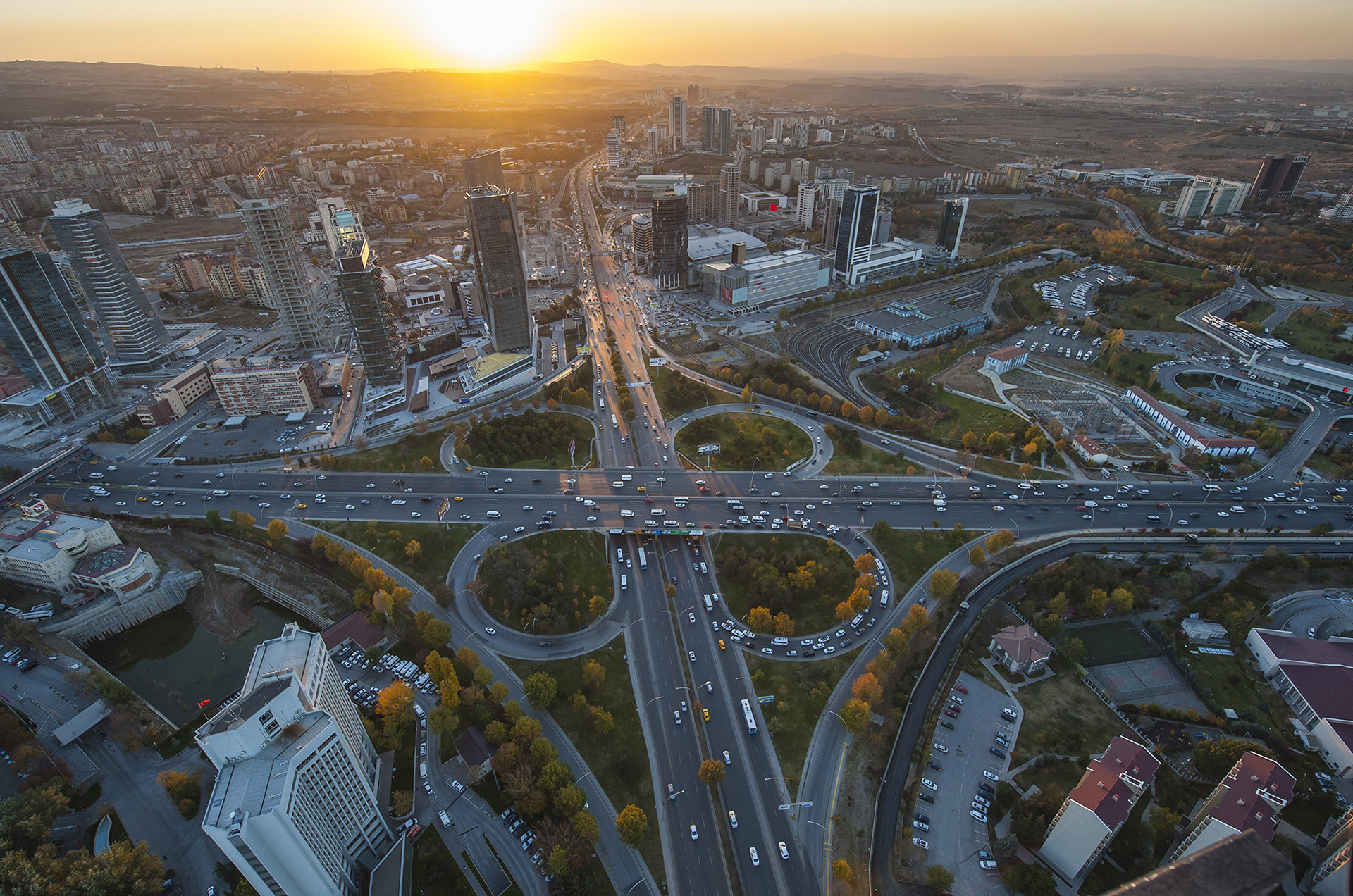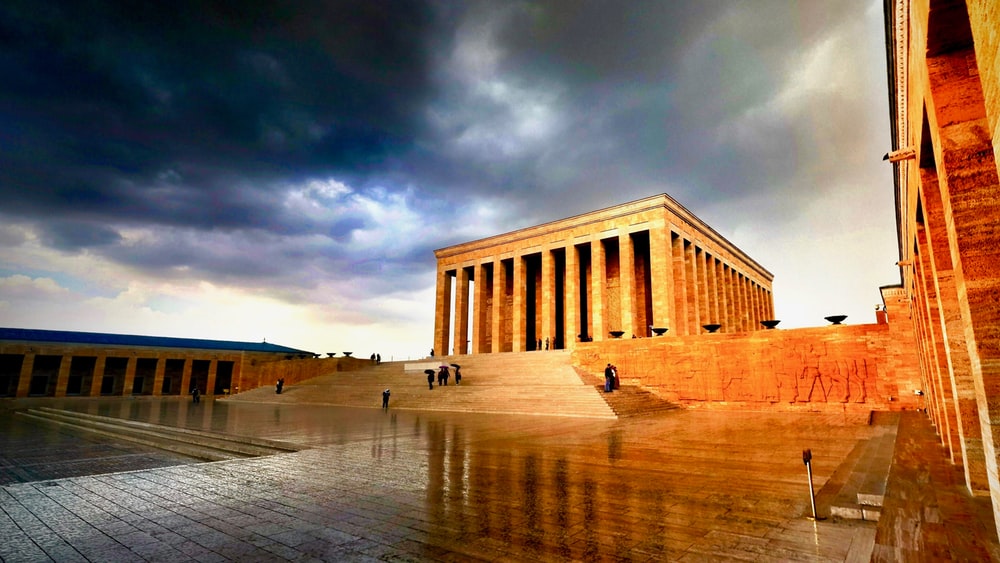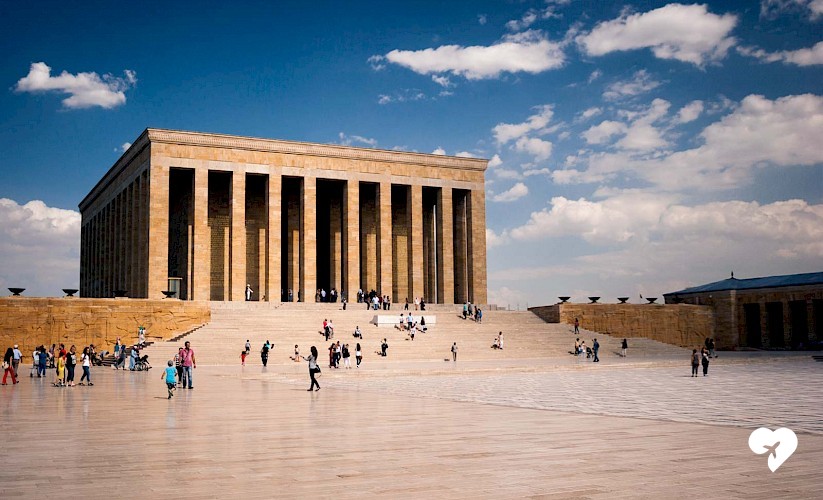- у дома
- Информация за нас
- Лечения
- Лечения
- ДЕСТИНАЦИЯ
- БОЛНИЦИ
- Контакти
Ankara
The city of Ankara lies in the centre of Anatolia on the eastern edge of the great, high Anatolian Plateau, at an altitude of 850m. With its yellow wheat fields, young volcanoes and infinite steppe, the plateau offers a stern landscape though a look at its history reveals millennia rich with emotive episodes.
Due to its location in the centre of the country, the region has been a historical junction of major trade routes and a crossroads of migratory streams. The Hittite Empire, one of the superpowers in antiquity, emerged here in Central Anatolia. The Hittites distinguished themselves not only through the civilisations they created, but also through the state structure they evolved and their tolerance and respect for human rights.
Throughout history, Ankara has witnessed battles between powerful armies in quest of domination. The city was an important cultural, trading and arts centre in Roman times and a major trading centre on the caravan route to the east in Ottoman times. However, it had lost importance by the 19th century. When Mustafa Kemal Atatürk chose Ankara as the base from which to direct the War of Independence, it once again became an important centre. By consequence of its role in the war and its strategic position, it was declared the capital of the new Republic of Turkey on October 13, 1923. Ankara, known until that time for its rabbits, cats and goats, became the geographic, political and administrative centre of Turkey, with all the government offices and foreign embassies transferred from İstanbul. This dramatic change profoundly affected the appearance of the city; what was in effect an ancient Anatolian town had to acquire a new personality quickly, a change which was made very successfully. It was no longer the modest Ankara of artisans and small tradesmen, but a city hosting politicians, government officials and foreign diplomats. The first buildings to alter the skyline of Ankara were the Museums of Ethnography and of Painting and Sculpture. They no longer stand alone and today Ankara counts a number of skyscrapers, large shopping centres, five-star hotels and bank headquarters.
Travel Back In Time
Moreover it was located on King Road which was one of the most important routes in ancient times, extending from Sardis, capital of Lydia, to Susa City in Mesopotamia. Ankara had been used as a settlement area continuously during the Phrygian, Galatian, Roman and Byzantine periods, and Alexander the Great was one of the most famous people that the city hosted. Ankara also came to the fore for its mohair obtained from Angora goats during the Ottoman Empire and became one of the important trade cities of the empire owing to its location on the Silk Road. Although the city entered a stagnant period alongside the general decline of the Ottoman Empire, it gained a new importance with the proclamation of the Turkish Republic and developed swiftly as the capital city that today is the second biggest metropolitan city in Turkey.

Ulus is the first area of Ankara where you can explore the traces of different civilisations side by side. Phrygians found the anchor that lent its name to Ankara here, and it was the city centre decorated by monuments during the Roman era. During Ottoman times, Ulus served as the heart of commercial activities and housed key commercial buildings. The transition from the Ottoman Empire to the Republic of Turkey was staged here, thus those who wish to familiarize themselves with Ankara should start their visit with Ulus.
Considered the first stop on excursions, Ankara Citadel bears the marks of all of the civilisations that have played a role in the city’s past. It has a presence in the cityscape of Ankara as it was built on the highest hill in the middle of Ankara plains, and utilized by every people that reigned in the region. Its history is evident by the inscriptions on its walls. In the citadel the Ankara houses, some of them dating back to the 17th century, and the Alaaddin Mosque, the oldest religious building in Ankara still open to worship, can be visited. The panoramic vista over Ankara from the top of the city walls is as breathtaking as it was to the sentries of the past.
Samanpazarı locality in Ulus, along with the Citadel, caravanserais and old houses, deserves to be termed an openair museum. The locality is full of antique dealers and souvenir shops and has several caravanserais and museums. Some of those shops are old Ankara houses from the Ottoman era restored to a new function and some are now restaurants or cafes.
While in Samanpazarı visit the Museum of Anatolian Civilisations, a museum considered to be one of the most notable in the world. It is housed in two refurbished Ottoman-era structures: One is a 600-year-old caravanserai, the Kurşunlu Caravanserai, and the other is the Mahmut Paşa Bedesten (a covered bazaar and strong structure built for the safekeeping of valuable commercial goods). A visit to the museum is the best way to be amazed by the splendours and riches of Anatolia's long history which goes back to the 7th millennium BC.
The Temple of Augustus, Column of Julian and the Hacı Bayram Mosque are also popular sites in Ulus that you should not miss visiting. The Temple was built by the Galatian King Pylamenes in 10AD as a tribute to Augustus, and was re-constructed by the Romans on the ancient Ankara Acropolis in the 2nd century. It is important today for the "Monument Ancyranum", the sole surviving political testament of Augustus, detailing his achievements and inscribed on its walls in Latin and Greek. In the 5th century the temple was converted into a church by the Byzantines. Erected in 362AD, most probably to commemorate a visit by the Roman Emperor Julian the Apostate, the Column of Julian stands 15m high and has a typical leaf decoration on the capital. Next to the Temple of Augustus is the Hacı Bayram Mosque; it was built in the early 15th century in Seljuk style and was subsequently restored by Sinan in the 16th century. In the 18th century ceramic tiles were added.
Located among the oldest settlements of Ankara, Hamamönü earned a new profile with the restoration projects that deemed it worthy of an award, and it has become a place that attracts most of the domestic and foreign tourist visits in Ankara. It reflects the style of urbanization and architectural features of the Ottoman period and the early years of the Republic. Also worth a mention is the Karacabey Turkish Bath, Taceddin Sultan Mosque and the Hacı Musa Mosque. There are also many restaurants, cafes and patisseries where you can try different types of food from Turkey’s various regions in the historic ambiance of Hamamönü.

This mausoleum, built between 1944 and 1953, is a magnificent, neo-classical building appropriately designed with sombre lines and set on a vast esplanade. The entry to the mausoleum, known in Turkish as Anıtkabir, is provided through a triumphant alley lined with granite lions. It is a fitting monument to the greatness of the founder of modern Turkey. There is a museum housing a wax statue of Atatürk, writings, letters and items belonging to him, as well as an exhibition of photographs recording important moments in his life and in the establishment of the Republic.
Arts And Culture
It also has a large number of theatres staging many ambitious productions. In addition to public and private galleries throughout the city, exhibitions are held at the Atatürk Cultural Centre.
The city has many cinemas showing the best Turkish and foreign films and there are a number of film festivals on various themes throughout the year, in particular the International Film Days in March. Every year in April and May the city hosts the International Arts and Music Festival with performances by the finest Turkish and foreign musicians. The Children's Festival on April 23 is also quite an event, with groups of children from all over the world taking part. The Asian-European Arts Biennial is scheduled sometime in the spring or summer.
Ankara has a distinct advantage for hosting national and international meetings as its location offers easy access for travellers and it has a welldeveloped infrastructure and transportation system, coupled with a rich cultural heritage and natural resources that make the city an ideal spot for congresses and meetings. It also has a range of hotels, resorts, universities and public buildings with well-established, state-of-the-art facilities which make them ideal locations for successful events of every kind.
Shopping
Walking up the hill to the Citadel Gate, there are many interesting shops selling spices, dried fruits, nuts and all manner of produce – the selection is huge and very fresh. Besides shops and stores in such central locations as Kızılay and Ulus, shopping malls in every part of Ankara host stores and shops, catering to all kinds of customers. Every year, the city of Ankara holds a shopping fest, welcoming visitors with many cultural and entertainment activities.
In Ankara, there is also a wide choice of places of entertainment where you can dance and enjoy yourself until sunrise. Gölbaşı, Ankara Citadel, Kızılay, Bahçelievler, Tunalı Hilmi Street, Tunus Street, Gaziosmanpaşa and Çayyolu are just some of the locations where you will find many traditional or modern entertainment venues.
The popular parks and recreation areas are Gençlik Park in Ulus, Kuğulu Park in Tunalı, Dikmen Valley in Dikmen and Altınpark in Aydınlıkevler with facilities such as restaurants, cafes and game areas.
The Environs of Ankara
One of the most important Phrygian sites in Anatolia is the ancient city of Gordion. Situated about 90km southwest of Ankara in the village of Yassıhöyük, Gordion was first inhabited in the late 3000BC. It has various layers of settlement belonging to the Hittites, the Phrygians, the Persians and the Romans, and according to legend the man who made Gordion a capital city for the first time was the Phrygian King, Gordias in the 8th century BC.
The ancient Gordians buried their deceased in tumuli and over 80 of these lie scattered across a large valley to the east of the village of Yassıhöyük. These ancient tombs vary in size and were originally built out of wood covered with a large pile of earth. The largest tumulus in Gordion is believed to be that of King Midas; it is the second largest tumulus found in Anatolia at 300m in diameter and 55m in height. A male skeleton, wooden tables, large cauldrons, bronze containers in various sizes and fibulas, lying beside the head of the skeleton, have been found in the burial chamber which was made out of wood and enclosed on four sides. Most of the artefacts recovered in the Gordion excavations are on display in the Museum of Anatolian Civilisations and at the Gordion Museum.
According to the famous Gordion legend, the Phrygians were in search of a new leader and they were told by an oracle to crown the first person to enter the city on an ox-cart. That person happened to be Gordias, whose ox-cart then got tied to a column by a knot of ivy. The ox-cart then became the focus of another legend, as it was said that the one who managed to untie the knot would become the ruler of Asia. In 334BC Alexander the Great made his way to Gordion to try and undo the knot. Unsuccessful, the impetuous Macedonian king drew his sword and cut the knot in two, going on to fulfil the prophecy by conquering much of Asia. However, his untimely death at the age of 33 was thought by some to have been caused by his unorthodox method of undoing the Gordian knot.
Further along the same Ankara- Eskişehir road is Ballıhisar (Pessinus), an important Phrygian religious cult centre. The most important remains there are those of a temple dedicated to Cybele, the mother goddess whose worship was at the heart of Phrygian culture with the small open-air museum having some interesting sculptures and tombstones.
At Gavurkalesi, 60km from Ankara on the Haymana Highway near Dereköy, the remains of an open-air Hittite temple, a tomb and two reliefs of Hittite gods are worth to visit.
Visitors to Ankara have the opportunity to enjoy nature, too. Twenty-five kilometres to the south of Ankara on the Konya road is Gölbaşı Lake, a popular place for its attractive scenery and its fine lakeside restaurants. Ahlatlıbel, is a favourite leisure area for Ankara residents, with its lovely trees and picnic sites. Another favourite place for picnics is Karagöl Lake, 68km north of the city on the airport road, for which one should take the turn off for the town of Çubuk.
Walkers will delight in exploring the three main forests around Ankara: south of the city on the Kırşehir Highway is the Beynam Forest, while to the north on the İstanbul Highway is the Kızılcahamam Soğuksu National Park and further along in the same direction is the Çamkoru Forest. All are delightful retreats from the clamour of the city and each provides many lovely places for picnics.
Elmadağ Mountain, some 23km east of Ankara, can be seen from most parts of the city. The first snowfall on the mountain heralds the start of winter and the beginning of skiing, other winter sports also being enjoyed at the pleasant resort centre.
The old county of Beypazarı, built on steep slopes and valleys, is extremely picturesque with its marketplace, traditional houses and natural landscape. Century-old Beypazarı houses reflect the typical characteristics of Ottoman and traditional Turkish domestic architecture.









